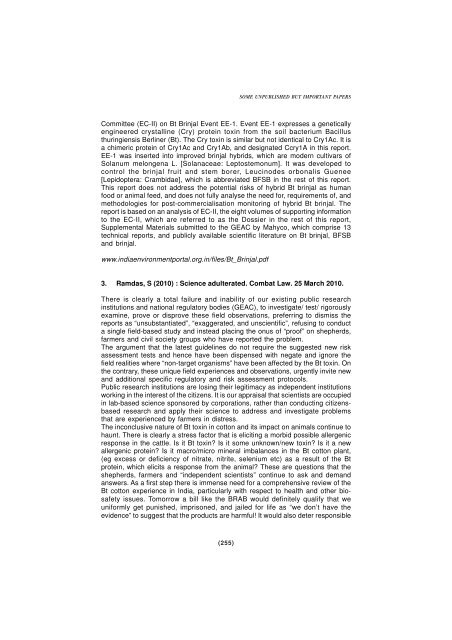omb3dyw
omb3dyw
omb3dyw
You also want an ePaper? Increase the reach of your titles
YUMPU automatically turns print PDFs into web optimized ePapers that Google loves.
SOME UNPUBLISHED BUT IMPORTANT PAPERSCommittee (EC-II) on Bt Brinjal Event EE-1. Event EE-1 expresses a geneticallyengineered crystalline (Cry) protein toxin from the soil bacterium Bacillusthuringiensis Berliner (Bt). The Cry toxin is similar but not identical to Cry1Ac. It isa chimeric protein of Cry1Ac and Cry1Ab, and designated Ccry1A in this report.EE-1 was inserted into improved brinjal hybrids, which are modern cultivars ofSolanum melongena L. [Solanaceae: Leptostemonum]. It was developed tocontrol the brinjal fruit and stem borer, Leucinodes orbonalis Guenee[Lepidoptera: Crambidae], which is abbreviated BFSB in the rest of this report.This report does not address the potential risks of hybrid Bt brinjal as humanfood or animal feed, and does not fully analyse the need for, requirements of, andmethodologies for post-commercialisation monitoring of hybrid Bt brinjal. Thereport is based on an analysis of EC-II, the eight volumes of supporting informationto the EC-II, which are referred to as the Dossier in the rest of this report,Supplemental Materials submitted to the GEAC by Mahyco, which comprise 13technical reports, and publicly available scientific literature on Bt brinjal, BFSBand brinjal.www.indiaenvironmentportal.org.in/files/Bt_Brinjal.pdf3. Ramdas, S (2010) : Science adulterated. Combat Law. 25 March 2010.There is clearly a total failure and inability of our existing public researchinstitutions and national regulatory bodies (GEAC), to investigate/ test/ rigorouslyexamine, prove or disprove these field observations, preferring to dismiss thereports as “unsubstantiated”, “exaggerated, and unscientific”, refusing to conducta single field-based study and instead placing the onus of “proof” on shepherds,farmers and civil society groups who have reported the problem.The argument that the latest guidelines do not require the suggested new riskassessment tests and hence have been dispensed with negate and ignore thefield realities where “non-target organisms” have been affected by the Bt toxin. Onthe contrary, these unique field experiences and observations, urgently invite newand additional specific regulatory and risk assessment protocols.Public research institutions are losing their legitimacy as independent institutionsworking in the interest of the citizens. It is our appraisal that scientists are occupiedin lab-based science sponsored by corporations, rather than conducting citizensbasedresearch and apply their science to address and investigate problemsthat are experienced by farmers in distress.The inconclusive nature of Bt toxin in cotton and its impact on animals continue tohaunt. There is clearly a stress factor that is eliciting a morbid possible allergenicresponse in the cattle. Is it Bt toxin? Is it some unknown/new toxin? Is it a newallergenic protein? Is it macro/micro mineral imbalances in the Bt cotton plant,(eg excess or deficiency of nitrate, nitrite, selenium etc) as a result of the Btprotein, which elicits a response from the animal? These are questions that theshepherds, farmers and “independent scientists” continue to ask and demandanswers. As a first step there is immense need for a comprehensive review of theBt cotton experience in India, particularly with respect to health and other biosafetyissues. Tomorrow a bill like the BRAB would definitely qualify that weuniformly get punished, imprisoned, and jailed for life as “we don’t have theevidence” to suggest that the products are harmful! It would also deter responsible(255)


